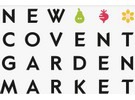
As Her Majesty Queen Elizabeth II celebrates her Platinum Jubilee on June 2nd, the traders at New Covent Garden Market can look back with pride on 70 years of supplying the Royal Households. The Queen has bought fruit and vegetables from New Covent Garden Market, the leading wholesale market in the country, throughout her reign, as the consumption habits of her nation have evolved to reflect availability of produce from around the world. The Queen’s excellent health has often been credited to a consistently nutritious diet, including plenty of fresh produce. Her Majesty has her favorites, of course, but the nation’s consumption habits have changed dramatically when it comes to fruit and vegetables in the last seven decades. When Her Majesty became Queen Elizabeth II in 1952, the country was still more than two years away from an end to 14 years of rationing due to the restrictions of World War II. The 1952 Office for National Statistics (ONS) basket of goods listed just potatoes (old and new), tomatoes, cabbages, cauliflowers, carrots, sprouts, peas, turnips, and onions as staple fresh vegetable items, while the fresh fruit range was limited to cooking apples, oranges, and bananas, with canned plums, pears and peaches also on the list. A pound of spuds cost 2d (18p in today’s money), 1lb of cabbages would set you back 4.5d (47p), and 1lb of oranges was selling for 1s¾d (£1.10). The fresh produce on the menu at The Queen’s Coronation State Banquet on June 3de, 1953, included English-grown products such as new potatoes, tomatoes, asparagus, and strawberries, and these four items have been on menus at Jubilee celebrations ever since. Even by the time the country was celebrating its monarch’s Silver Jubilee in 1977, the nation’s standard shopping basket had not bulged too much in size, though some of the items had changed. The variety of potatoes available had widened, while mushrooms were added to the vegetable list at the expense of turnips and peas (frozen peas having taken hold). Dessert apples and pears had made their way onto the fresh fruit list. Another quarter of a century on, as the Queen celebrated 50 years on the throne in 2002, the ONS had seen fit to add cucumbers, lettuce, organic vegetables, and pre-packed salads to their list of most popular vegetables. The fruit basket was far larger by this stage, though – with bananas having knocked apples off their perch as the nation’s favorite fruit. The average Briton now not only regularly purchased the aforementioned cooking and dessert apples, pears, bananas, and oranges, but also strawberries, grapes, grapefruit, avocado, peaches, organic fruit, and kiwifruit. By 2012, nectarines and easy peeler citrus had made their way into the fruit basket, alongside vegetable counterparts peppers, broccoli, and courgettes. Another fruit mentioned in dispatches was persimmon, sales of which were increasing at a faster rate than either the now popularised kiwifruit and avocado. DDP Ltd, of New Covent Garden Market, which has held a Royal Warrant and supplied the Royal Household for the last two of her Jubilee milestones (in 2002 and 2012), will also supply the fresh produce for this year’s events. “The British public’s buying habits have changed as the world has become smaller and availability of products from every corner of the globe has widened our horizons and sharpened our taste buds,” said DDP’s Managing Director, Paul Grimshaw. “The main staples still mostly remain in our baskets, but we’ve developed our culinary skills and woken up to ways to value the flavors of fruit and vegetables, as well as the incredible health benefits they provide. “This year, statistics show that strawberries are the nation’s favorite fruit, followed by white and red seedless grapes, with bananas now demoted to fourth place. So things keep evolving, but one thing that has stayed central to the menus of the Royal Households, however, is British-grown produce, and for the Platinum Jubilee, British Heritage tomatoes, asparagus, Jersey Royals, and strawberries will play a big role,” said Paul. Jo Breare, General Manager of Covent Garden Market Authority, the landlord and management company at New Covent Garden Market, added: “One of the changes we’ve seen in recent times is a welcome reduction in the amount of fruit and vegetables wasted in the supply chain, as people across the world have recognized our responsibility to the environment. New Covent Garden Market is a zero to landfill site now, and the traders here are all working towards a more eco-friendly and sustainable future in everything that we do. “New Covent Garden Market will be putting out the bunting and celebrating the Jubilee in style in the week of the Platinum Jubilee, and everyone here extends our congratulations and sincere gratitude to The Queen for her magnificent service to the country.” Here are a few more fresh produce milestones during the Queen’s time on the throne:
1975
Iceberg lettuce was introduced to the UK.
1990s
Exotic salad leaves such as rocket and lollo rosso become mainstream, as do sun-dried tomatoes.
1994
Little gem lettuce and cherry tomatoes are widely available for the first time.
1996
Bananas become more popular than apples.
2000s
Courgettes, mange tout, and corn on the cob become more popular than cabbage and carrots, consumption of fruit reaches an all-time high, and there is a rise in the intake of “superfoods” such as blueberries, spinach, soy, watercress, and mangos.
2010
Gala overtakes Cox as the UK’s favorite apple, and blueberries overtake raspberries in the popularity stakes.
2010s
Micro leaves gain popularity – especially in the restaurant trade. Source: New Covent Garden